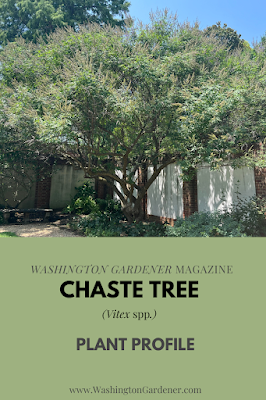Vitex Plant
Profile
Chaste Tree (Vitex spp.) is a small tree that is native to the Mediterranean and Asia. It has been cultivated for thousands of years both for its ornamental value and herbal uses.
The tree blooms profusely in mid-July. The flowers are fragrant and the leaves are also scented. It also produces a fruit, which is technically a drupe, but is commonly referred to as a berry. The seeds from the dried fruit are ground and used as a pungent peppery spice. The seeds, the roots, and bark are all used in traditional medicine.
Vitex is a great addition to the butterfly garden. It is reported that our native pollinators all visit the Chaste Tree. The Vitex flowers also make the most valuable and best varieties of honey.
This is a fast-growing tree that grows to a height of about 20 feet within a few years and then expands to about 20 feet in width.
Vitex is often mistaken for Butterfly Bush (Buddleia spp.) as the flower panicles are similar. They are light purple and upward-pointing, but their leaves are very different looking. As a matter of fact, the foliage of the Chaste Tree is often mistaken for Cannabis, because of the fine-toothed leaf pattern!
It is also known as the Texas Lilac tree or the Arabian Lilac. Vitex can thrive in heat where real Lilacs would whither, so it is widely available and popular in the Southern US.
Chaste Tree prefers well-drained soil and full sun. Once the root system is developed, Vitex is drought-tolerant. It is best to plant it during the spring, after the soil has warmed up, to give it plenty of time to develop its root system before the winter season.
Prune it in early spring to remove any crossing and dead branches. Also remove any upright sprouts. Then train it to be a tree form or shrub shape as you wish. Vitex can also be a good container-grown tree. Snip off the spent flowers right after they start to lose their color to encourage a rebloom about six weeks later.
Vitex is deer-resistant due to the fragrance. Wear gloves when handling this plant. As with many aromatic plants, skin contact can cause an allergic reaction.
Vitex agnus-castus, the straight species, and the cultivar ‘Shoal Creek’ are available in tree form at many area garden centers. Among the newer cultivars are compact shrub forms like ‘Pink Pinnacle’ and ‘Blue Pinnacle.’ Also, look for the dwarf ‘Blue Diddley’.
Warning that the round-leaved Vitex (Vitex rotundifolia) was brought to the East Coast in the 1980s for use as a coastal soil stabilizer. It has now naturalized in some states and is an aggressive spreader. It is not available for purchase commercially.
Vitex: You Can Grow
That!
The
video was produced by Washington Gardener Magazine as part of our Plant
Profile series for Mid-Atlantic USA gardeners.
Video and editing by Taylor Edwards
Audio and text by Kathy Jentz
➤ If you
enjoy this video, please give it a thumbs up and subscribe to our
Youtube channel (thank you!)
➤Remember
to TURN ON notifications to know when our new videos are out
➤ FIND
Washington Gardener Magazine ONLINE
~
WashingtonGardener.blogspot.com
~
http://twitter.com/WDCGardener
~
https://www.instagram.com/wdcgardener/
~
Facebook.com/WashingtonGardenerMagazine
~ Podcast: GardenDC
PIN THIS FOR LATER!




No comments:
Post a Comment